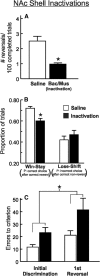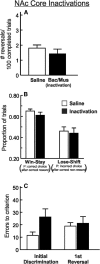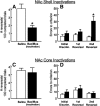Preferential involvement by nucleus accumbens shell in mediating probabilistic learning and reversal shifts
- PMID: 24672007
- PMCID: PMC6608131
- DOI: 10.1523/JNEUROSCI.5058-13.2014
Preferential involvement by nucleus accumbens shell in mediating probabilistic learning and reversal shifts
Abstract
Different subregions of nucleus accumbens (NAc) have been implicated in reward seeking, promoting flexible approach responses, suppressing nonrewarded actions, and facilitating shifts between different discrimination strategies. Interestingly, the NAc does not appear to mediate shifting between stimulus-reward associations (i.e., reversal learning) when reinforcement is predictable. How these nuclei may facilitate flexible response strategies when reward delivery is uncertain remains unclear. We investigated the effects of inactivation of the NAc shell and core on probabilistic reversal learning using an operant task wherein a "correct" response delivered reward on 80% of trials, and an "incorrect" response was reinforced on 20% of trials. Reinforcement contingencies were reversed repeatedly within a session. In well-trained rats, shell inactivation reduced the number of reversals completed and selectively reduced win-stay behavior. This impairment was apparent during the first discrimination, indicating a more general deficit in the use of probabilistic reward feedback to guide action selection. Shell inactivation also impaired reversal performance on a similar task where correct/incorrect choices always/never delivered reward. However, this impairment only emerged after both levers had been associated with reward. Inactivation of NAc core did not impair reversal performance but increased latencies to approach the response levers. These results suggest the NAc shell and core facilitate reward seeking in a distinct yet complementary manner when the relationship between specific actions and reward is uncertain or ambiguous and cognitive flexibility is required. The core promotes approach toward reward-associated stimuli, whereas the shell refines response selection to those specific actions more likely to yield reward.
Keywords: cognitive flexibility; nucleus accumbens; probabilistic reinforcement learning; rat; reversal learning.
Figures




Similar articles
-
Multifaceted Contributions by Different Regions of the Orbitofrontal and Medial Prefrontal Cortex to Probabilistic Reversal Learning.J Neurosci. 2016 Feb 10;36(6):1996-2006. doi: 10.1523/JNEUROSCI.3366-15.2016. J Neurosci. 2016. PMID: 26865622 Free PMC article.
-
Dissociable roles for the nucleus accumbens core and shell in regulating set shifting.J Neurosci. 2006 Mar 1;26(9):2449-57. doi: 10.1523/JNEUROSCI.4431-05.2006. J Neurosci. 2006. PMID: 16510723 Free PMC article.
-
Contributions of basolateral amygdala and nucleus accumbens subregions to mediating motivational conflict during punished reward-seeking.Neurobiol Learn Mem. 2017 Apr;140:92-105. doi: 10.1016/j.nlm.2017.02.017. Epub 2017 Feb 24. Neurobiol Learn Mem. 2017. PMID: 28242266
-
Motivational views of reinforcement: implications for understanding the behavioral functions of nucleus accumbens dopamine.Behav Brain Res. 2002 Dec 2;137(1-2):3-25. doi: 10.1016/s0166-4328(02)00282-6. Behav Brain Res. 2002. PMID: 12445713 Review.
-
Translational tests involving non-reward: methodological considerations.Psychopharmacology (Berl). 2019 Jan;236(1):449-461. doi: 10.1007/s00213-018-5062-x. Epub 2018 Oct 10. Psychopharmacology (Berl). 2019. PMID: 30306228 Free PMC article. Review.
Cited by
-
Neural networks supporting switching, hypothesis testing, and rule application.Neuropsychologia. 2015 Oct;77:19-34. doi: 10.1016/j.neuropsychologia.2015.07.019. Epub 2015 Jul 18. Neuropsychologia. 2015. PMID: 26197092 Free PMC article.
-
Prefrontal cortical and nucleus accumbens contributions to discriminative conditioned suppression of reward-seeking.Learn Mem. 2020 Sep 15;27(10):429-440. doi: 10.1101/lm.051912.120. Print 2020 Oct. Learn Mem. 2020. PMID: 32934096 Free PMC article.
-
Adaptive learning under expected and unexpected uncertainty.Nat Rev Neurosci. 2019 Oct;20(10):635-644. doi: 10.1038/s41583-019-0180-y. Nat Rev Neurosci. 2019. PMID: 31147631 Free PMC article. Review.
-
Ketamine decreases sensitivity of male rats to misleading negative feedback in a probabilistic reversal-learning task.Psychopharmacology (Berl). 2017 Feb;234(4):613-620. doi: 10.1007/s00213-016-4497-1. Epub 2016 Dec 8. Psychopharmacology (Berl). 2017. PMID: 27933365 Free PMC article.
-
Distinct Action Signals by Subregions in the Nucleus Accumbens during STOP-Change Performance.J Neurosci. 2024 Jul 17;44(29):e0020242024. doi: 10.1523/JNEUROSCI.0020-24.2024. J Neurosci. 2024. PMID: 38897724 Free PMC article.
References
Publication types
MeSH terms
Substances
LinkOut - more resources
Full Text Sources
Other Literature Sources
Miscellaneous
